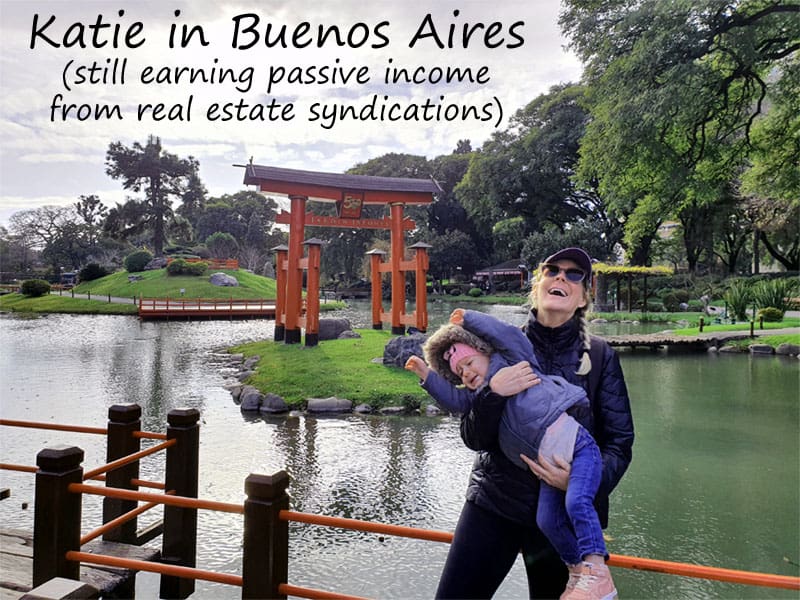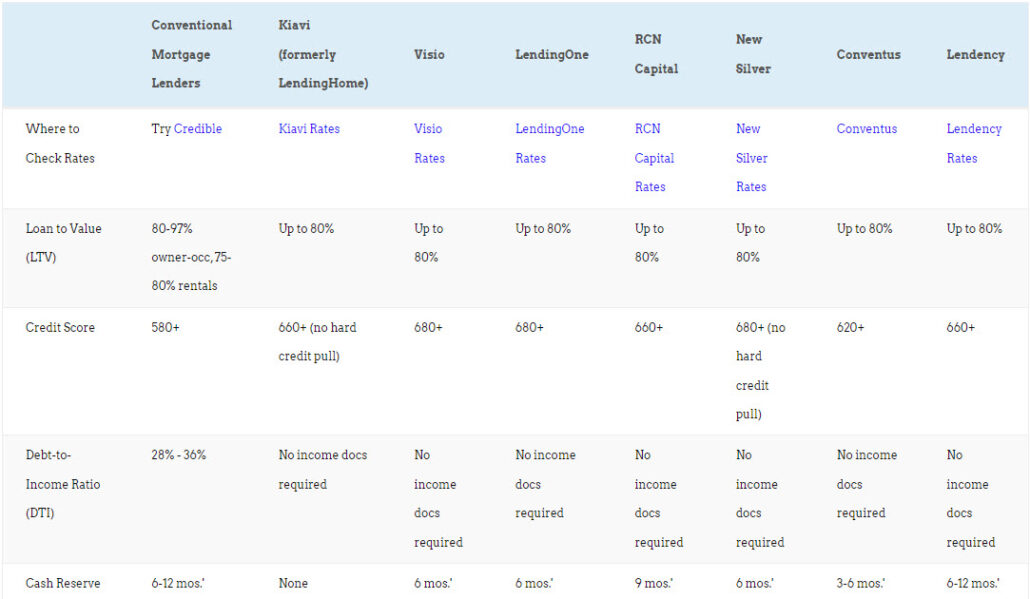
In personal finance circles, people love to say that the average millionaire has seven streams of income.
As far as I can tell, it’s neither a hard fact nor a quote by a famous person. But it still has a nice ring to it — and it conveys a deeper truth.
With enough passive income, you no longer need to work and earn active income. You reach financial independence and are able to cover your living expenses solely with streams of passive income from investments. At that point, you can spend your days traveling, playing golf, playing with your kids, volunteering, or working on passion projects.
But how do you create passive income streams?
17 Passive Streams of Income from Real Estate
Sure, there are other sources of passive income, such as dividends from stocks, interest from bonds, or business revenue from digital products or affiliate links. But at SparkRental, we’re all about passive income through real estate.
As you start building passive streams of income to replace your day job income, keep the following ideas in mind. And remember, you don’t have to pick just one — I earn streams of passive income from many of the sources below!
1. Real Estate Syndications
Most of us don’t have millions of dollars to invest in an apartment building or other commercial property. The good news: you don’t need millions if you buy fractional ownership in real estate.
It works like this. A professional real estate investor (the syndicator) finds a good deal, and then approaches potential partners to raise most of the money. The syndicator puts in some of their own money and raises the rest from these silent partners. Despite owning a minority share of the property, the syndicator maintains most of the control and responsibilities of renovations and day-to-day property management.
The financial investors — known as limited partners or LPs — earn passive streams of income from the rents each year. When the property sells, everyone gets paid out according to their ownership percentage, although the syndicator earns extra for their extra work.
On the plus side, investors typically earn high returns, in the 15-30% range, and get full tax benefits. Unfortunately, syndications usually require a minimum investment similar to the down payment and closing costs for a rental property, in the $25-100K range. Strict federal regulations also cause many real estate syndications to only accept money from accredited investors.
But plenty of syndicators (AKA sponsors) do allow non-accredited investors, even though they can’t market to them. Which is why we launched our Co-Investing Club: to allow everyday people to invest small amounts of money in these sorts of large real estate projects. Non-accredited investors can participate, with as little as $5K per deal.
That makes it far easier to spread money across many different properties, compared to buying a rental property or investing in a real estate syndication by yourself. If you want all the benefits of real estate investing without becoming a landlord, consider investing passively in syndications.
2. Fractional Ownership in Rental Properties
If $5,000 still sounds like a lot to invest, consider starting smaller by buying fractional shares in single-family rental properties.
Platforms like Arrived, Ark7, Lofty, and Concreit let you buy ownership shares for $20-100. You collect cash flow, each property adding a stream of passive income. And when the property sells, you earn your share of the profits.
Some platforms, like Ark7 and Lofty, even offer secondary markets to let you sell shares to other investors. Both require a minimum holding period, but after that, you can sell shares whenever you like.
Don’t expect returns as high as real estate syndications. But you still get the tax benefits of property ownership, albeit without the accelerated depreciation that comes with syndications.
3. Long-Term Rental Properties
Everyone understands the classic model for passive income through real estate: buying a property and signing a lease agreement with long-term tenants.
But the very simplicity of the premise is what gets so many new investors into trouble. They think that because they get the concept of rental income, they also know everything they need to know about the business of buying and managing rental properties.
Which is why so many new real estate investors make so many costly mistakes.
As you look into buying your first rental property, learn how to run the numbers to calculate cash flow accurately. Use a free rental cash flow calculator, and include expenses like vacancy rate and property management fees. While you can buy a rental property with no money down, watch out for too much leverage. Learn exactly what real estate due diligence you need to perform before sinking tens of thousands into a single investment.
For all those warnings, rental properties make an excellent passive income source. So much so that rentals can help you retire early with their ongoing income that rises over time and serves as a hedge against inflation.
4. Short-Term Vacation Rentals
No one says you have to sign a long-term lease agreement with tenants. It’s your property, and you can rent it short-term on Airbnb if you prefer. At least, you can in most parts of the country — some cities don’t let you use your property how you see fit.
Depending on your city and neighborhood, you can earn higher returns renting your property short-term as a vacation rental. You can even use tools like Mashvisor to compare cap rates and returns on a property used either as a long-term or short-term rental. See our full Mashvisor review for details.
But the short-term vacation rental business requires more labor on your part as well. More frequent turnovers mean frequent cleaning, plus a much higher vacancy rate.
You also have to furnish and decorate the property, unlike long-term rentals.
If the idea of running a vacation rental business appeals to you, start with these tips to become an Airbnb host. You don’t even necessarily need to buy the property. You could lease a property and then rent it on Airbnb, a strategy known as rental arbitrage. Just beware that you need to forecast your cash flow accurately, or else you risk losing money rather than making it.
5. Mid-Term Corporate Rentals
Who says you can’t have your cake and eat it too? As a hybrid between the long-term and short-term rental business models, consider corporate rentals.
You provide a furnished rental property to corporate renters, such as travel nurses or business travelers, who need an extended stay of 2–6 months. You don’t have to constantly clean or do laundry, and you don’t have to worry about frequent vacancies.
But the renters pay a premium, and take great care of your property — because your client is typically the employer, not the guest. Your occupant knows that it will get back to their employer if they mistreat the property, so they take excellent care of it.
For a free webinar explaining the business model and how to use rental arbitrage, see this webinar we hosted with Al Williamson. If you’re looking for passive income ideas that don’t require much cash, learn Al’s rental arbitrage strategy.
6. House Hack with an ADU or Basement Apartment
In the traditional multifamily house hacking model, you buy a 2–4 unit property, move into one unit, and rent out the other(s). Your neighboring tenants pay enough rent to cover your entire mortgage payment, so you effectively “live for free.”
But that’s not the only way to house hack and score free housing. You can also house hack single-family homes by adding an accessory dwelling unit (ADU), basement apartment, garage apartment, or in-law suite.
Or by bringing in housemates, or renting out storage space, or even hosting a foreign exchange student like our cofounder Deni did. Check out our free house hacking calculator to run the numbers, no matter how you plan to house hack.
For that matter, you can also add passive streams of income by renting out parking or storage.
7. Rent Out Parking or Storage Space
In urban areas short on parking, you can rent out your parking pad or other space for neighbors to park their car. But your options for earning passive income from parking don’t end at the city limits. Suburban and rural residents can also earn money by renting out parking spaces for large vehicles like trucks, boats, RVs, and beyond. Covered parking commands a higher premium, but uncovered parking works too. You can also earn good money renting out a space for mobile homes to park, whether in passing or long-term. Water and electric hookups help, but they aren’t necessary if you only serve RVers passing through. It may not seem like much extra cash each month, but even an extra $50 or $100 each month adds up when compounded over years. For that matter, you can also rent out storage space in your garage, basement, attic, or elsewhere. Check out Neighbor.com as a reputable marketplace connecting storage renters and providers.8. Mobile Home Parks
Some investors lift their noses at the idea of owning a mobile home park. That very lack of competition helps mobile home parks perform even better for investors in the know. Regulations have prevented many new mobile home parks from opening in recent years, restricting supply even as demand for cheap real estate has grown. Mobile home parks also offer the ultimate affordable housing, making them recession-resilient assets. In fact, they tend to perform well in all market cycles. And no, you don’t need to manage the park yourself. You can hire a property management company to handle the day-to-day operations, leaving the investment a (mostly) passive source of income. It’s a business like any other, and requires certain skills and knowledge to succeed. If it appeals to you, take a course on it — we recommend Mobile Home University as a reputable option.9. Invest in Individual Mobile Homes
Rather than investing in entire mobile home parks, some investors buy individual mobile homes. They turn around and rent these out to families on a long-term lease agreement, often with an option to purchase. They cost far less than a single-family house and offer much higher returns. And with even less competition, because they’re not “sexy” investments. Often you earn the best returns from the most “niche” passive income strategies! Listen to our podcast episode on mobile home investing with Rachel Hernandez, AKA The Mobile Home Gurl, and check out her free mobile home investing course for more details.10. Undeveloped Land
Of all the types of real estate investments, land comes with the least regulation, and in many ways the fewest headaches. You don’t have to worry about maintenance or repairs. You don’t have to worry about tenants damaging your property. For that matter, you don’t have to worry about going through the lengthy and expensive eviction process if your renters don’t pay. If someone rents your land for the occasional camping trip or hunting, and they stop paying rent, you simply cancel the rental agreement with them and they lose the right to use your land. Plus, land is cheap. At least relative to single-family homes or a commercial property. That makes it far easier to buy in cash and avoid investment property loans, while still earning extra money each month from direct real estate investments. If you’re interested in learning how to invest in raw land, take Seth Williams’ excellent land investing course over at REtipster. And if you’re on the fence, check out this land investing case study, where a corporate worker replaced his 9-5 salary in just 18 months. It makes for another “unsexy” investment, which is precisely why it can be so profitable. Investors earn money by flipping land, either in one up-front payment or as a stream of passive income by signing a seller-financed note. (More on private notes shortly.)11. Self-Storage Facilities
Self-storage facilities offer another not-so-sexy way to invest in real estate, with similar advantages. While you do have to maintain a physical structure — unlike land — the buildings are far simpler than residential properties. They come with minimal mechanical systems like electrical, plumbing, and HVAC, sometimes avoiding them entirely. You don’t have to worry about long eviction processes or complex landlord-tenant laws either. Instead, the business largely comes down to marketing and keeping your vacancy and turnover rates low. If you can find a good deal on a self-storage facility, and keep your vacancy rate low, you can earn strong cash flow and an easy passive income stream.12. Commercial Real Estate
Commercial properties range in use from office space to retail, restaurants to industrial. You can go as small as a corner shop, or as big as a skyscraper. The category also includes residential buildings with five or more units. When you buy an apartment building with at least five units, you have to take out a commercial loan, rather than a residential investment property loan. If the high cost troubles you, keep in mind that it also deters much of your would-be competition. Commercial real estate investors face far less competition than residential investors, which often leads to higher cap rates and returns. Even so, expect a much higher minimum investment than many other passive income opportunities on this list. Like any other type of real estate investment, consider starting small then scaling up as you build confidence and expertise.13. Publicly-Traded REITs
Alternatively, you can buy shares in a real estate investment trust (REIT). These companies trade on public stock exchanges, so anyone with a brokerage account can buy shares. You can invest in equity REITs, which own real estate properties directly, or mortgage REITs, which own debts secured against real property. Either way, REITs tend to pay extremely high dividends. That’s because the SEC requires REITs to pay out at least 90% of their profits each year to shareholders, in the form of dividends. That makes it easy to create passive income streams with REITs, but it also limits their potential for share price growth. The companies can’t reinvest profits to grow their portfolios, limiting their ability to rise in value. Their instant liquidity also comes with a downside: volatility. Because they trade on public stock exchanges, they also tend to move in close concert with stock markets. That limits their usefulness for diversifying away from stocks.14. Crowdfunded REITs
If only you could buy shares in a REIT without the volatility or limits on growth potential… Oh wait, you can. Over the last decade, real estate crowdfunding investments have skyrocketed in popularity. Most of these sell shares in pooled REIT funds, which either own properties or real estate-secured debt or both. But you buy shares directly from the company itself, rather than buying and selling shares on stock exchanges. That reduces volatility to nearly nothing, but it also makes it much harder to sell shares. In most cases, you sell shares back to the company rather than on the secondary market, but they restrict you from selling shares in the first 2–5 years of owning them. That makes real estate crowdfunding investments a long-term commitment. Still, they have far more flexibility to grow their funds’ value by reinvesting profits. That gives share prices plenty of room to grow over time. Just as easy to buy as public REIT shares, real estate crowdfunding shares offer true diversification from the stock market. They earn you returns based on income yield and real estate market fundamentals, rather than moving in correlation with stocks. Some crowdfunded REITs allow you to invest with as little as $100, or $500 or $1,000. Regardless of the exact number, it’s far lower than a down payment on a rental property. I’ve invested in Fundrise and Streitwise, for example. But see our full list of real estate crowdfunding investments for all the options available.15. Crowdfunded Real Estate Loans
Not all crowdfunded real estate investments work like pooled funds where you buy shares. As an alternative model, you can invest money toward specific loans, secured against real estate. You pick and choose the loans you want based on the interest rate, the loan term, the property location, the LTV (loan-to-value ratio), and the borrower’s qualifications. My favorite of these real estate peer-to-peer lending platforms is GroundFloor. They allow retail investors (non-accredited investors), and you can make an initial investment as low as $10. Best of all, GroundFloor issues short-term loans, so you don’t have to lock your money up for five years at a time. As a hard money lender, they provide short-term fix-and-flip loans for house flipping or the BRRRR strategy. You can invest in loans ranging in term from 6–18 months.16. Private Notes
Of course, you could also skip the middleman and lend directly to the borrower. A promissory note is the legal document that borrowers sign when they take out a loan. You can lend money to other real estate investors directly, and sign a private note with them. I do this with investors I know and trust, who have a track record of success. For example, I lent $25,000 at 10% on an interest-only note to an investing couple I know. As an interest-only loan, they don’t make payments toward their principal balance — they pay me 10% of the loan balance each year as interest. That means $2,500 per year as a passive stream of income for me. Often, sellers offer owner financing to their buyer when they sell a property. That way, they not only earn a profit from selling the property, but also interest on it as a stream of passive income. You can negotiate any terms you like with the borrower. That includes interest rate, loan term, amortization versus interest-only, and any up-front fees such as points. So, you can invest for any period of time, as negotiated with the borrower. If you like, you can also record a lien against the property so you can foreclose if the borrower defaults. Word to the wise, however: only lend money to experienced real estate investors you know and trust well. If they default, it falls to you to enforce the note and recover your money. “Neither a borrower nor a lender be,” and all that.17. Joint Venture with a Partner
Like one of the streams of passive income outlined above, but don’t have any experience with it? Find someone who does. Learn the shortcuts, the pitfalls, all the expensive lessons that cost them thousands of dollars that you can skip. That could mean partnering with a veteran real estate investor and lean on their expertise and network of lenders, contractors, real estate agents, and beyond. Learn the ropes on a partnered deal or two, to build confidence before buying properties on your own. You don’t necessarily need any investing capital, either. You can offer to contribute your labor toward the deal. Or you could partner with someone who knows private note investing, or mobile home park investing, or self-storage, or any other niche outlined above. And if you’re interested in passive investing in real estate syndications, you can always join our Co-Investing Club. Just sayin’. Finding people further down the path than you is the fastest way to start building passive streams of income.Other Sources of Passive Income
Real estate isn’t the only source of passive income, of course. Bonds pay interest. Some stocks pay dividends, as do some ETFs (exchange-traded funds) and mutual funds. Just don’t expect massive yields. Branching out to more alternative assets, you can buy shares in franchises. Check out FranShares, which lets you buy shares in a fund that owns dozens of franchises and pays distributions on the cash flow. You can even buy rights to royalties. For example, Public offers royalties to the music featured in the Shrek franchise. Every time someone plays a song from a Shrek movie, it generates revenue. If you have a great eye behind the camera, you can earn money from stock photos. If you write the next great American novel, you’ll earn residual income from sales in perpetuity. Or if you create a great blog, you can earn passive income from affiliate marketing. And so it goes. Get creative, and diversify among many different streams of income.Final Thoughts
How close are you to reaching financial independence? Are you close to building enough streams of passive income to cover half your living expenses? All of them? Play around with our financial independence calculator to see where you stand. Whether you’re just starting out or making fast progress toward financial freedom, aim to create a passive income stream every single month. That could be as simple as buying more shares in a REIT or setting up recurring investments with a real estate crowdfunding platform, or as involved as buying a new rental property. Each dollar of extra income you earn makes it easier to save and invest more, to compound and grow exponentially over time. Where you stand today doesn’t matter. Just start making tangible progress every single month, and you’ll find yourself reaching financial independence faster than you’d think.♦ How many sources of income have you built? What are your questions about how to create passive income streams?More Real Estate Investing Reads:
About the Author

G. Brian Davis is a real estate investor and cofounder of SparkRental who spends 10 months of the year in South America. His mission: to help 5,000 people reach financial independence with passive income from real estate. If you want to be one of them, join Brian and Deni for a free class on How to Earn 15-30% on Fractional Real Estate Investments.



























Mobile home parks are a great passive income stream!
I’ve never owned a mobile home park, but I’d definitely love to own a share of one!
Undeveloped land is an interesting passive income stream.
Land comes with some unique advantages. I particularly like the easier regulation.
Wow, there is so much to learn! Thanks for the info.
Just start with one strategy to keep it manageable at first. Dive deep into that one passive income strategy, and avoid costly mistakes in it. You can expand into other passive streams of income from real estate later.
If I am going to choose my top 3 on the list, base on my current status, I would choose house hack w/ basement apartment, undeveloped land, and joint venture with a partner. I am just running a small team and I think those are the best passive streams of income I can do best.
I love it Allan! Keep us posted on your progress!
I’m glad to find this blog as I am looking for where to invest. This is a good read!
Thanks Jack, glad to hear it was helpful!
The hardest part is where to begin. I guess I will read more of your blogs until I am knowledgeable enough to start building my passive income. Thanks for sharing. Keep it up!
I recommend starting simple with a real estate crowdfunding investment. Start with $10 just to see how the platforms work. Keep us posted!
Rental is still the best passive income and then invest in crowd funding sites. That’s the easiest way to reach financial independence!
I hear you Stephanie!
This list is a goldmine for anyone looking to diversify their income through real estate! I’m particularly interested in exploring fractional ownership in rental properties. Has anyone had success with this?
Hi Austin, I’ve invested in a few platforms, including Arrived and Ark7. I like the secondary market on Ark7, makes it a shorter-term investment with more liquidity.